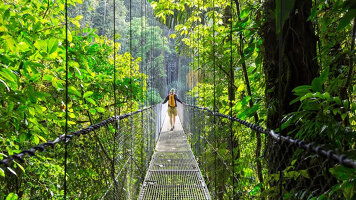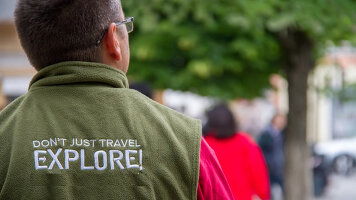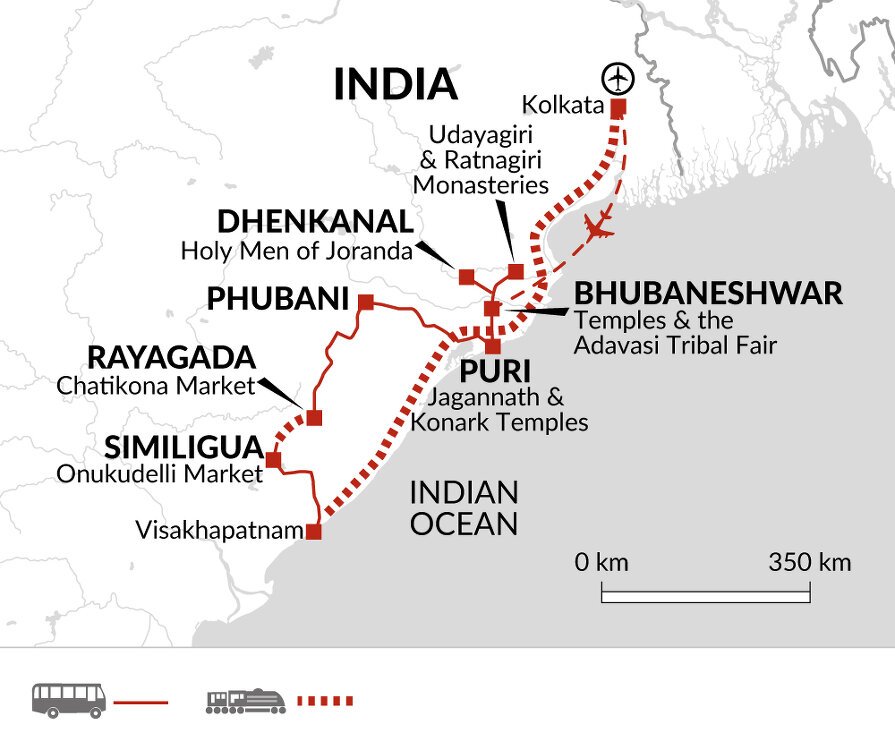Overview
Itinerary
Our tour of Orissa starts in Kolkata. Once the capital of British India, Kolkata has had a turbulent past. It was central to the struggle for Indian independence and thousands of Bengali refugees came here at the start of the 1900s. It's a city of striking contrasts and can be overwhelming initially, but the sights, smells and chaotic sounds offer a unique introduction to life in the bustling state. For those arriving in time today, our tour leader will meet you in the hotel reception at 2pm for a welcome meeting followed by a short walk around the Kalighat area of the city. This area is densely populated and known for its temple, which is dedicated to the goddess Kali. If you'd like an airport transfer today, you'll need to arrive into Kolkata Airport (CCU), around a one-hour drive from the hotel. If you'd like to join the walk in Kalighat today, you'll need to arrive at the hotel by 2pm. If you're booking your own flights, you should give yourself at least one and a half hours to clear the airport and then one hour to reach the hotel. Your flight should arrive at 11.30am at the latest. Should you miss the welcome meeting, your tour leader will catch you up as soon as possible. Stay: Peerless Inn (Comfortable)
Today is dedicated to exploring the gems of Kolkata. We'll visit St John's Church and the many historic Raj buildings around Dalhousie Square, the Jain temples, Mother Theresa's home and the magnificent marble dome of the Victoria Memorial, where the grandeur of European and Moghul influences come together. We'll also visit the clay modellers' village of Kumartuli where the potters spend all year creating images and idols for the annual festivals. As the festival time approaches the streets here are filled with an overwhelming display of brightly coloured and richly attired idols. Stay: Peerless Inn (Comfortable) (B)
Today we'll journey to Dhenkanal, taking the morning flight to Bhubaneshwar and then continue our journey by road. The drive will take around five to six hours with stops en route. We'll make a stop in Nuapatna, a small village where locals make a living making textiles on looms in their home workshops, which they then sell at the local market. Next, we'll drop by Sedabarni, a village famous for its Dhokra metalwork, using a casting technique that has existed in India for more than 4000 years. The technique involves creating artefacts from wax which are then used to make a clay mould. The wax is melted away and replaced by molten metal before the clay is broken to reveal the final piece of art. Subjects often include animals and tribal people. We'll reach Joranda, in the Dhenkanal district and the centre of the Mahima Dharma religion, in time to see the late afternoon ceremony. Founded by Mahima Swami in the 1800s, the religion shunned the elitism of Hindu Brahmanism, opposed the caste system, and embraced those from lower levels of society. Its followers worship a single, formless god and believe in universal kindness, non-violence, and freedom from greed. An hour before sunset, the holy men of the religion, clad only in saffron loin cloths, practice rites involving fire, chanting, and prostrating before the setting sun. Followers of the religion from nearby communities join them to receive blessings. This evening, we'll spend the night in the company of royalty at the Maharajah's Dhenkanal Palace. With the atmosphere of an aristocratic homestay rather than a hotel, we'll be welcomed by the estate's staff (and the Maharajah and Maharani themselves if they're in residence). All the rooms are part of the original palace with furnishings from years gone by giving us a sense of the palace's rich past. Stay: Dhenkanal Palace (Comfortable) (B/L/D)
This morning, we'll drive for three hours to reach the Udayagiri and Ratnagiri Monasteries. Active between the 7th and 12th centuries, the site is composed of stupas, temples, statues, carvings, and monasteries. We'll spend some time exploring before continuing for another two to three hours to Bhubaneshwar, often referred to as 'temple city', and the capital of the state of Orissa. Stay: Hindustan International Bhubaneswar (Comfortable) (B)
Today is dedicated to exploring the delights of Orissa's capital. With over 500 temples, the city of Bhubaneshwar earns its status as 'temple city' and is referred to in old Hindu scriptures as one of Lord Shiva's favourite places. The name of the city is derived from Shiva's Sanskrit name, Tribhubaneswar, meaning 'lord of three worlds'. We'll take a walk through an area that houses over 100 temples, including some of the most important in Hinduism. Along the way, we'll see the elaborate Lingaraja Temple, the largest in the city, which has intricate carvings of various Hindu deities, and a rare Brahma temple, located on the edge of the Bindusagar River. Even though he is one of the main Hindu gods, there are few temples dedicated to Brahma. Legend says this is because as the creator of the universe he has done his job so there is simply no need to worship him, others point to darker reasons, such as Brahma being worshiped by demons or even that he has been cursed never to be worshipped because of his unacceptable behaviour. In the afternoon, we'll visit a tribal museum before making our way to the Adivasi Mela. Adivasi translates as 'original people' and reflects the fact that the tribal people are the first inhabitants of the area, and of the Indian subcontinent. Each year their cultures are recognised at a 'mela' or fair, held in Bhubaneshwar, where people from the 62 tribes come together to celebrate their unique cultural identities. The mela runs for two weeks each year from January 26th. If your departure date coincides with the end of the festival, it might not be as busy, but it still gives us the unique opportunity to experience the culture of different tribes. Stay: Hindustan International Bhubaneswar (Comfortable) (B)
Just outside of Bhubaneshwar, Dhauli Hill is a peaceful spot located on the banks of the River Daya. It's also the site of the infamous battle of Kalinga. Here, in 262 BC, the Emperor Ashoka's army won a bloody confrontation with the state of Kalinga at the cost of a quarter of a million lives. After seeing the horrors of war, Emperor famously converted to Buddhism and renounced violence. He inscribed pillars, carvings, and rock faces all around his kingdom with messages of peace and tolerance, and teachings of Buddhist Dharma, or law. There are 33 of these inscriptions remaining today, including one carved into an elephant-shaped rock at the site of the battle.
On our way to Puri, we'll stop at the village of Pipli. Established in the 10th century to accommodate the craftsmen who made the applique umbrellas and canopies for the Jagannath Temple in Puri, the village is still home to these craftsmen and their workshops today. As well as making the colourful canopies, they craft everyday items such as wall hangings and lanterns used at Diwali.
Puri is one of the four holiest cities in India, a pilgrimage site for Hindus, and home to the 12th-century Jagannath Temple, named for Lord Jagannath, the 'Lord of the Universe' and a form of Vishnu. The English word juggernaut is derived from this deity and refers to the massive, unstoppable chariots that are used in the temple's processions which would reputedly crush devotees under their wheels in years gone by.
Only Hindus are allowed inside the temple, but we can walk around the outside and take in the architecture, carvings and buildings, including one of the world's largest kitchens. Here, 56 varieties of vegetarian food are cooked daily as offerings to Lord Jagannath. The food is then shared amongst the needy and some of it is sold in the temple's Ananda Bazaar, next to the temple. Stay: Hotel Shrer Hari (Comfortable) (B)
This morning, we'll drive for one hour to the Konark Sun Temple, a UNESCO World Heritage Site built in 1250. The temple is in the shape of a giant chariot and the stone wheels are sundials that are said to be able to tell the time to an accuracy of a single minute. Legend has it that the temple emits an aura of great power, which local stories attribute to two very powerful magnets hidden in the structure that used to allow the king's throne to hover in front of impressed crowds. Near the temple, we'll visit a fishing community at Chandrabagha beach and see how the fishermen use traditional boats and methods to make their living from the sea. In the afternoon, we'll have free time to explore at your own pace. You might like to wander along Puri's beach or pay another visit to the Jagannath Temple. Stay: Hotel Shrer Hari (Comfortable) (B)
We'll start just after dawn today, setting out on the waters of Chilika Lake. The largest coastal lagoon in India and the second largest in the world, it's a haven for migratory birds, especially from October to March when it plays host to over 160 species including white-bellied sea eagles, purple moorhen, flamingos, and storks. The lake is also home to around 150 Irrawaddy dolphins - though these can be difficult to spot. The shores are dotted with small communities that fish from their traditional wooden boats. After an hour or so on the water, we'll begin our journey to Phulbani and the tribal heartland of Orissa. The drive is around six to seven hours including stops for lunch and comfort breaks. Stay: KP Salunki (Comfortable) (B/D)
This morning, we'll drive for two hours to the starting point of our four-kilometre walk. Our walking route will take us through villages inhabited by the Kondh people. Like all the tribal groups of Orissa, they are indigenous to the subcontinent and pre-date the Dravidians and Aryans that the majority of the Indian population descends from. The Kondh are the most numerous tribe and are split in to various subsets. Today we'll meet the Kutia Kondh, who can be distinguished by their tattooed faces, a tradition that began with the arrival of European colonists in an attempt to make the women of the tribe less attractive and prevent assaults. This tradition has only recently ceased and the youngest people we're likely to see with a tattooed face will be in their early twenties. Most Kondh villages have a place to sacrifice animals to the gods of the hills before planting a new crop, or after harvesting a successful one. In the past, they used to practice human sacrifice, known as Meriah, and it was considered honourable to be sacrificed on behalf of the community. Their ancient belief system is based on animism and the worship of nature and ancestors, although today many aspects of other religions have been adopted, and some tribal people have converted completely to Hinduism, Christianity, or Islam. We'll continue to drive deeper into the tribal belt, heading for Rayagada. On the way, we'll stop for a picnic lunch, and then wander around the colourful weekly market at Kotgarh. A note on visiting the tribes: The tribal people whose villages we visit today, and who we will meet at the markets, have limited interaction with the wider world. Your tour leader and local guide will work carefully to ensure that their sensitivities are considered and that we do not do anything to cause offence or disrespect their way of life. You might find the tribes a little more reticent than most Indian people, but by following the tour leader's and local guide's advice regarding interaction and photographs, you'll get a glimpse into their fascinating cultures. Stay: Hotel Sai International (Comfortable) (B/L/D)
Today we'll visit a local market, frequented by the Dongria Kondh tribe. Dongria means 'hills' and refers to the fact that the Dongria Kondh live at higher altitudes and worship the mountain God 'Niyam Raja'. Once a week people of the tribe descend to trade at the local market at Chatikona. The girls and boys of the tribe leave their families once they reach adolescence, living in separate dormitories until they get married. The groom has to pay a 'bride price' for the honour of marrying and this can include a period of time when he has to work for the bride's family for free. The ladies have distinctive dress with combs in their hair, three nose rings and colourful necklaces. The location of the Chatikona market is next to a train line and we'll hop on a local passenger train most of the way to our next destination, Similiguda - a journey of around three hours. It's not possible to reserve seats and we'll likely have to stand for the first few stops but we'll be rewarded with a truly local experience. The train trundles through the countryside, stopping at rural stations while people board and alight with their loads from the market. It's worth noting that the rail service can be unreliable, but we have the option to drive if we need to. Stay: Hotel Lemon Castle (Comfortable) (B/L/D)
Today we'll spend some time at Onukudelli market. The Bonda tribe live high up in the hills and their only regular interaction with the outside world is at this market where they come to buy provisions and sell the liquor they produce, walking many miles through the hills to get there. It's thought that their culture has changed little in the last 1000 years. The society is matriarchal and boys generally marry at around 10 to 12 years old with their brides usually being six to 10 years older. As with the Kondh, the groom has to pay a bride price, which the bride might have to repay if they divorce. The dress of the women is quite distinctive with thick silver bands around their necks and long strings of colourful beads that cover most of their torsos. Their heads are shaved and covered with a cloth and another piece of cloth - called a 'ringa' - goes around the waist. The men wear less interesting attire, but carry their bows and arrows with them, even to the market. These are used mainly for hunting but also for self-defence. After a couple of hours in and around the market, we'll visit the nearby Duduma Waterfall. We'll be near the top of the falls, able to look down as the waters crash to the green valley below - a great spot to enjoy our picnic lunch before driving back to the hotel. Stay: Hotel Lemon Castle (Comfortable) (B/L/D)
We'll have a long drive of around six to seven hours today, passing through beautiful countryside and small villages before arriving in the port city of Visakhapatnam, the largest city of Andhra Pradesh. There'll be time for a quick look around and dinner on the beach before boarding the Coromandal Express overnight train. Travelling along almost the entire coast of Orissa, the train arrives mid-morning at Kolkata's Howrah Junction railway station, the biggest and busiest railway station in India. Stay: Overnight Train from Vizag to Kolkata (Simple) (B)
We'll arrive in Kolkata late morning, and after checking in to the hotel the rest of the day is free for you to relax or explore more of the city. You might like to take a cruise on the Hooghly River, enjoy a walk of the old colonial areas or visit the Dakshineswar Kali Temple. Stay: Peerless Inn (Comfortable)
Our tour of Orissa ends at our hotel in Kolkata. There are no activities planned today, so you're free to depart at any time. If your flight leaves later in the day, luggage storage facilities are available at our hotel. If you'd like a hotel transfer, you'll need to depart from Kolkata Airport (CCU), around a one-hour drive from the hotel. (B)
Trip Inclusions

Launching in 1981, Explore Worldwide offer trips from over 130 countries - from classic small group tours. Read more

Explore's leaders are more than just your typical guide. They're your local expert are are passionate about sharing their expertise with you. Read more

The places Explore stay are every bit as important as the sights they visit and the things you do. Read more
Download Brochure

Explore Worldwide Small Group Adventures (2025-26)
Prices & Dates
There are currently no departures available on this trip. Either it's the end of the season and new departures will be released shortly, or this itinerary has been changed and is not operating this season. Feel free to contact us for information about when next seasons dates will be released or click here to view general release dates for all destinations.
Tour & cruises prices are per person. Prices shown have savings applied, are subject to availability and may be withdrawn at any time without notice. Pricing and trip details are correct at this point in time, however are subject to confirmation at the time of booking and are subject to change by Explore. For cruise itineraries, cabin images are sourced from the cruise-line and should be treated as indicative only. Cabin inclusions, upholsteries and room layout may differ to the image(s) shown depending on the ship selected and your sailing dates.









